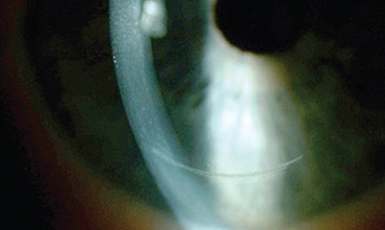 Q: Patients are asking about bladeless laser cataract surgery. What do I tell them?
Q: Patients are asking about bladeless laser cataract surgery. What do I tell them?
A: “When patients ask about bladeless cataract surgery, I explain that it is the wave of the future for cataract surgery,” says Andrea Knouff, OD, of Omni Eye Services in Atlanta. Traditional cataract surgery, by comparison, hasn’t changed much in more than 30 years—it’s still performed by using a small blade held by a human hand.
“Now, with bladeless cataract surgery, the femtosecond laser makes all the incisions and breaks up the cataract in under a minute,” Dr. Knouff says. “So far, the laser has shown that it’s more accurate than a blade in the surgeon’s hand, so it has the potential for a sharper and more precise visual outcome.”
 |
| The femtosecond laser can perform precise arcuate
incisions. |
The laser’s ability to break up the cataract also has benefits. “The studies are showing we’re able to remove the cataract with a lot less energy inside the eye compared to the standard procedure,” Dr. Woodard says. “So, we think this could be healthier for the eye in the long term because were using less energy to remove the cataract.”
However, be sure to tell the patient that this is a premium service not covered by insurance.
“Then patients always ask, ‘Is it worth it for me to spend extra money to get it done with the laser?’ Because of the benefits, I say, ‘Yes, it is. If it’s something you can afford, there’s no reason not to have it done with the laser,’” Dr. Woodard says.
Q: What should I look for postoperatively? Is the post-op care much different?
A: The postoperative concerns are the same as with conventional cataract surgery, but there are some subtle differences.
“Postoperatively, you’ll see a series of perfect cuts where the primary and secondary incisions were made,” Dr. Knouff says. “If cylinder has been treated, you’ll note the precise corneal relaxing incisions. You’ll also see a perfectly round circular area where the anterior capsulotomy was made.”
Overall, the laser yields a more accurate and precise outcome with typically less anterior segment inflammation.
“Sometimes the eye is a little red after surgery because the suction from the laser’s eyepiece can cause a subconjunctival hemorrhage,” Dr. Woodard says. But this usually goes away in a few days or a week with no treatment necessary.
Lastly, “One benefit that we’re finding is that more patients are getting 20/20 after surgery without the need for glasses,” he says. “Because this laser is more precise in making the opening incisions and more precise with treating astigmatism, more patients are less dependent on glasses afterward compared to traditional cataract surgery.” n

